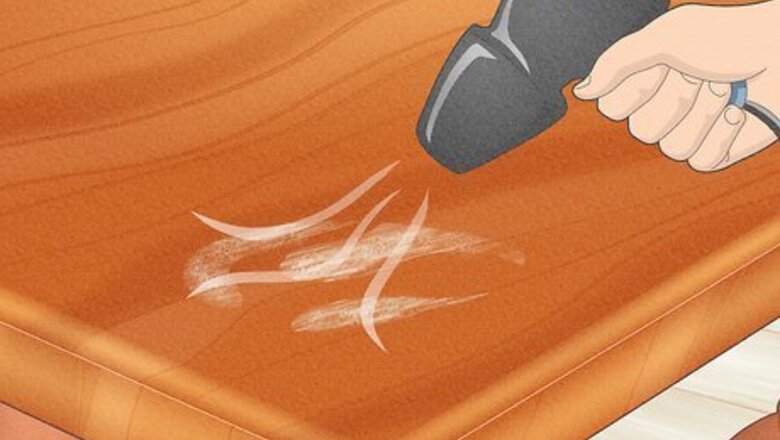
views
- Use heat from a hair dryer or an iron to reopen the wood’s pores and evaporate the moisture that caused the stain.
- Apply oily products like mayonnaise, petroleum jelly, or olive oil with a cloth or fine-grade steel wool to penetrate the wood and lift the stain.
- Sand away the stain and refinish the wood as a last resort. When in doubt, take your heat stained wood to a professional to avoid accidental damage.
Reheat the stain with a hair dryer.
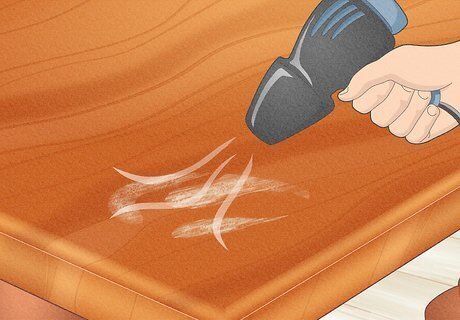
Set your hair dryer on low heat and move the head around the stain. Check on the stain every 2 minutes to see your progress. Keep the hair dryer in constant motion around the stain to avoid damaging the finish and repeat as necessary, making sure not to use the hair dryer for more than 2 minutes at a time. As the wood reheats, its pores will re-expand and the hair dryer will evaporate the stain-causing moisture.
Iron the stain out.

Place a cloth over the stain and heat your iron to its lowest setting. If your cloth is very thin, fold it once to protect the wood finish. Iron over the cloth to reheat and lift the stain, keeping the iron in constant motion so you don’t scorch the wood. Check the stain every minute or so, increasing your iron’s heat one level at a time until the stain begins to fade. Once the stain begins to lift, stop increasing the iron’s heat. This method may take around 10 minutes depending on the severity and size of the stain.
Apply toothpaste and baking soda.
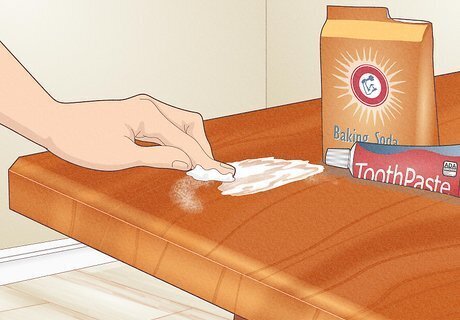
Mix white, non-gel toothpaste with baking soda and rub it over the stain. Use your fingers to apply the mixture in the same direction as the grain of the wood. Rub gently and let the mixture sit for a few minutes, then wipe it away with a clean cloth. Wipe again with a damp cloth and check to see if the stain is gone. Repeat this process until the stain is completely lifted out of the wood. Once it’s gone, wipe the table dry with a clean cloth. Make sure to use non-gel toothpaste since it’s the least abrasive type. Look for the simplest toothpaste with the fewest ingredients you can find.
Rub the stain with mayonnaise or petroleum jelly.
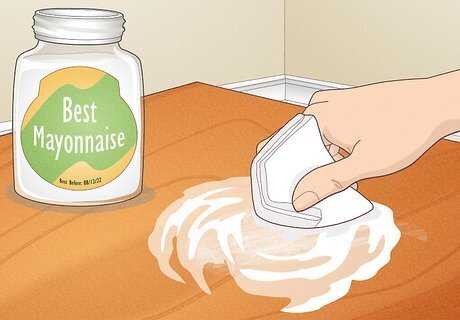
Oily substances like mayo can penetrate the wood and absorb the stain. Add a thick dab of mayo or petroleum jelly to a clean cloth and rub it into the stain in a circular motion. Cover the entire stain (add another dab if needed) and let it sit for at least a few minutes. Wipe the mayo or jelly away with a clean cloth to check the stain. Once the stain is gone, wipe down the table with a damp cloth to remove excess mayo or jelly. For old, stubborn stains, let the mayo or jelly sit for several hours (or even overnight if needed). Repeat this process until the stain is fully gone.
Scrub the stain with fine-grade steel wool and olive oil.
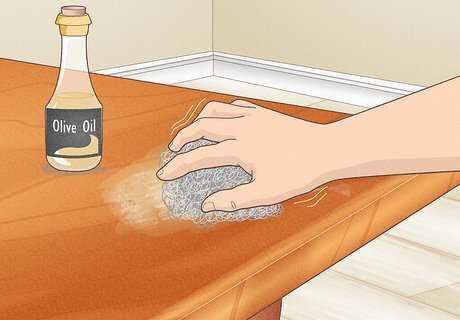
Soak the steel wool in oil before rubbing it on your wood finish. Scrub gently back and forth along the grain of the wood, pausing every minute or so to check if the stain is lifting. Remove excess oil with a clean cloth and repeat until the stain is gone. Try mixing your oil with a few drops of liquid dish soap for a stronger clean. Rub with a light touch to avoid damaging the finish of the wood. If you notice little scratches, buff out the spot afterward to restore the finish. Alternatively, try vegetable or lemon oil.
Scour the stain with equal parts white vinegar and oil.
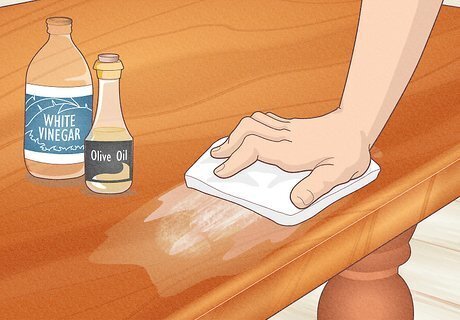
Mix the vinegar and oil in a bowl and soak a clean cloth in the solution. Rub the stain vigorously until it’s gone, then wipe the mixture away with a different clean cloth. Use any oil you have available—olive, lemon, vegetable, or mineral oil are all effective at lifting wood stains. Repeat as much as needed to remove the stain fully. A combination of vinegar and oil is thicker and more effective than plain vinegar by itself (although it is possible to lift the stain without oil). Keep distilled, white vinegar handy in your cleaning supplies cabinet—it’s useful for removing a variety of stains from lots of different surfaces!
Absorb the stain with a salt paste.
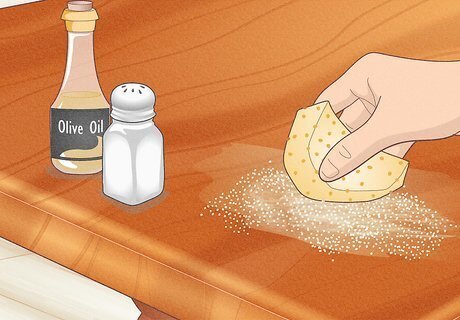
Combine 1 teaspoon (5.7 g) of salt with a few drops of water or oil. Use a clean cloth or sponge to rub the paste-like mixture into the stain using circular motions. Keep rubbing until the white spots have disappeared, then wipe the wood clean with a different cloth. Salt is a natural abrasive that will buff the whiteness out as well as absorb the moisture that caused the stain in the first place. Consider adding some furniture polish to the area afterward to restore the shine.
Polish the stain with car wax.
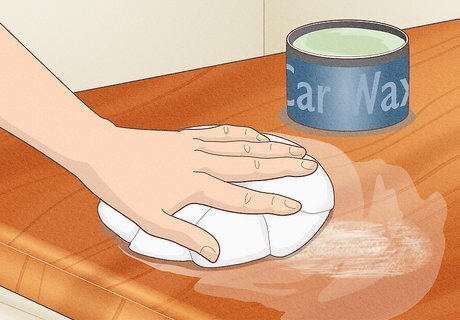
Car wax can lift stains from wood and shine your furniture’s finish, too. Apply the wax to the stain with your fingers and wait for it to dry out. Buff the wax off with a soft, clean cloth and check the stain. If it’s still there, add more wax and repeat. Car wax takes 1 to 24 hours to dry depending on the type of wax, the temperature and humidity, and the thickness of the wax layer. If you’re hesitant about using car wax on your interior furniture, try substituting furniture polish.
Sand the stain away.

As a last resort, remove the stained finish with fine-grit sandpaper. Use 220-grit paper or higher and rub in the direction of the grain of the wood. This works best on wood with multiple layers of varnish since you can add a new layer afterward. Wipe the area with a damp cloth and let it dry after the stain is gone. Sand very lightly to remove as little of the wood or finish as possible. Most tabletop veneers are only about 1/40 in (0.6 mm) thick. Try a cabinet scraper instead of sandpaper. It won’t get plugged up with dust like sandpaper will, so it may save some time and money. Evaluate the wood after the stain is gone. You may need to buff out sand marks or apply a new layer of varnish or finish to restore the area. Sandpaper or scrapers give you more finesse and control over how much you remove than a chemical remover does.
Take your furniture to a restoration expert.

If nothing works, consult a professional to avoid damaging your wood. There are lots of factors that impact your success, like whether the wood is soft or hard, how thin the finish is, and how deep or old the stain is. A professional wood restoration or furniture expert will know how to safely remove the stain from your specific wood to make it look as good as new.


















Comments
0 comment